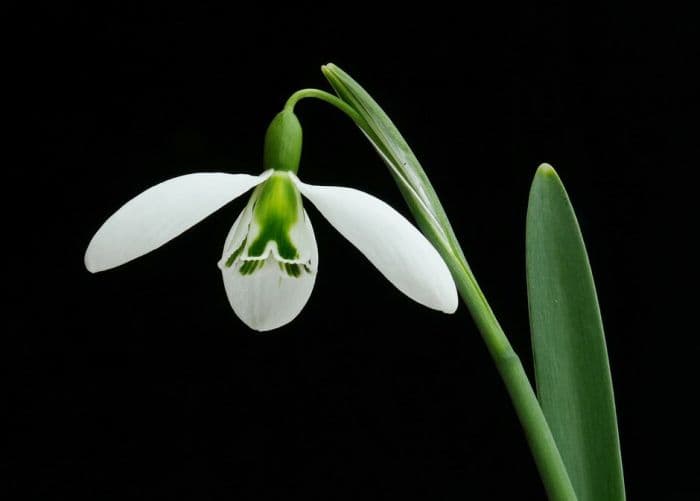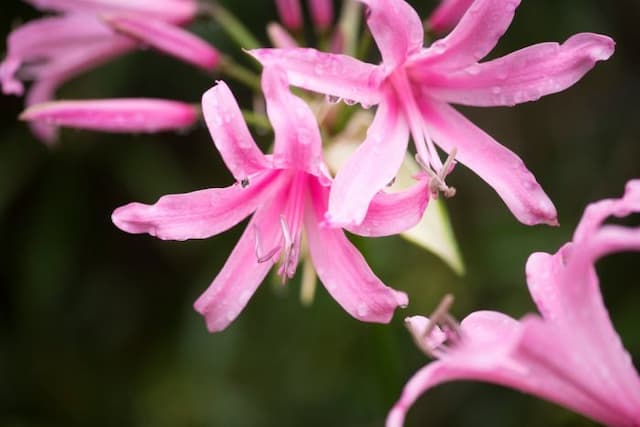Snowdrop Galanthus 'John Gray'

ABOUT
Galanthus 'John Gray', commonly known as snowdrop, is a charming plant renowned for its delicate appearance. It boasts slender, arching leaves that are a fresh, glossy green. The standout feature of this plant is its flowers. Each bloom has a classic snowdrop shape, with three outer petals that are pure white and slightly curved, resembling an elegant droplet as they hang from the flower stalk. Inside, you'll find inner petals that are shorter and often have distinctive green markings, adding a touch of contrast to the snowy whiteness. The flowers have a nodding habit, which gives the plant a demure and poised look. Overall, the snowdrop 'John Gray' exudes a sense of purity and simplicity with its modest yet captivating blossoms.
About this plant
 Names
NamesFamily
Amaryllidaceae
Synonyms
Snowdrop, Common Snowdrop
Common names
Galanthus 'John Gray'.
 Toxicity
ToxicityTo humans
The plant Galanthus 'John Gray' is commonly known as Snowdrop. Snowdrops contain alkaloid compounds which can be toxic if ingested by humans. The plant, particularly the bulbs, contains galantamine, which is a substance that can cause gastrointestinal upset, including nausea, vomiting, diarrhea, and abdominal pain. If a large quantity of the plant is consumed, more severe symptoms such as dizziness, confusion, or even tremors could occur. Ingesting any part of the plant could potentially lead to the need for medical attention due to these toxic effects.
To pets
The plant Galanthus 'John Gray', commonly referred to as Snowdrop, is also toxic to pets. Ingestion of any part of the Snowdrop, especially the bulbs, can lead to symptoms such as vomiting, diarrhea, abdominal pain, and hypersalivation in pets. More serious symptoms can include changes in heart rate, tremors, and seizures if consumed in large quantities. Consumption of Snowdrops by pets should be treated as a potential poisoning event, requiring immediate veterinary attention.
 Characteristics
CharacteristicsLife cycle
Perennials
Foliage type
Deciduous
Color of leaves
Green
Flower color
White
Height
4-6 inches (10-15 cm)
Spread
3 inches (7.5 cm)
Plant type
Bulb
Hardiness zones
3-8
Native area
Europe
Benefits
 General Benefits
General Benefits- Aesthetic Appeal: The Galanthus 'John Gray', commonly known as the snowdrop, adds delicate beauty to gardens with its nodding white flowers that are among the first to bloom in late winter or early spring.
- Ease of Care: Snowdrops are low-maintenance plants that require minimal care once established, making them ideal for novice gardeners.
- Cold Resistance: Snowdrops are hardy plants capable of withstanding cold temperatures and frost, making them suitable for cooler climates.
- Pest Resistance: These plants tend to be resistant to most pests, reducing the need for chemical treatments.
- Naturalizing: Snowdrops can spread over time to form natural-looking drifts, which can enhance the design of woodland gardens and other naturalized areas.
- Pollinator Attraction: Snowdrops provide an early source of nectar and pollen for bees and other pollinators, which is crucial as food sources are scarce in late winter.
- Ground Cover: When planted in drifts, snowdrops provide an effective ground cover, which can help prevent weed growth and soil erosion.
- Companion Planting: Snowdrops pair well with other early spring bloomers and can be used to underplant shrubs and trees, adding layers of interest to the garden.
 Medical Properties
Medical PropertiesThis plant is not used for medical purposes.
 Air-purifying Qualities
Air-purifying QualitiesThis plant is not specifically known for air purifying qualities.
 Other Uses
Other Uses- Galanthus 'John Gray', commonly known as Snowdrop, can be used as a natural pest repellent in gardens due to its production of a substance called galantamine, which can deter certain pests.
- Snowdrops can be planted to provide an early source of nectar for pollinators such as bees when not many other plants are flowering.
- The plant can be cultivated for artistic purposes, such as snowdrop photography or botanical illustration, especially when they bloom in winter landscapes.
- Snowdrops can act as a natural soil improver by breaking through hard soils, which helps to aerate the soil and improve its structure over time.
- They are used in winter gardens to create aesthetic appeal through ‘snowdrop walks’ or 'snowdrop carpets' where the blooms create a white floral blanket.
- Cultivated snowdrops like 'John Gray' can be utilized in winter festivals or botanical events that celebrate early spring blooms and gardening.
- These plants can be used in horticultural therapy programs, as their early blooming can have a positive impact on mental well-being during the late winter months.
- Snowdrops are sometimes used in literature and poetry as symbols of purity, hope, and the return of life, which can be influential in cultural arts.
- Educational programs related to botany and plant life cycles can use snowdrops like 'John Gray' to illustrate bulb growth and early spring plant behavior.
- The plant can inspire design motifs in textiles, wallpaper, and other interior decorations, especially in themes related to the transition from winter to spring.
Interesting Facts
 Feng Shui
Feng ShuiThe Snowdrop is not used in Feng Shui practice.
 Zodiac Sign Compitability
Zodiac Sign CompitabilityThe Snowdrop is not used in astrology practice.
 Plant Symbolism
Plant Symbolism- Purity: The snowdrop, which Galanthus 'John Gray' is a variety of, often symbolizes purity due to its clean, white petals that emerge even through snow, suggesting innocence and fresh starts.
- Hope: It is one of the first flowers to bloom at the end of winter, hence it represents hope and the arrival of happiness after hard times.
- Consolation or Sympathy: Snowdrops can also signify sympathy, especially because they appear when the weather is still cold and inhospitable—offering comfort in adversity.
- New Beginnings: The emergence of snowdrops often coincides with the beginning of spring, symbolizing new life and new beginnings.
 Water
WaterSnowdrops, commonly known as Galanthus 'John Gray', require minimal watering since they are mostly dormant during the dry season and they receive enough water from natural rainfall. During their growth period in late winter to spring, if there is less than 1 inch of rain per week, provide additional water to maintain moist soil. Ensure the soil is well-draining to prevent waterlogging. Water with approximately 1 gallon of water per square foot every week during dry spells.
 Light
LightSnowdrops like Galanthus 'John Gray' thrive in partial shade to full sun. The ideal spot for them is under deciduous trees where they get early spring sunlight before the trees leaf out, and then dappled shade thereafter. They can also grow well on the north side of a building where they receive some morning sun but are protected from the intense afternoon light.
 Temperature
TemperatureSnowdrops, also known as Galanthus 'John Gray', prefer cooler temperatures and are hardy in a range between 10°F to 75°F. They are ideal for temperate climates and can survive brief periods of colder temperatures down to around 10°F. The optimal temperature range for their growth and flowering is 35°F to 51°F.
 Pruning
PruningSnowdrops such as Galanthus 'John Gray' generally do not require typical pruning. However, it's good practice to remove spent flowers after blooming, and to cut back foliage only after it has yellowed and died back naturally, usually by late spring. This helps divert the plant's energy back into the bulb for the next growing season.
 Cleaning
CleaningAs needed
 Soil
SoilSnowdrops like Galanthus 'John Gray' thrive in a soil mix that is well-draining, rich in organic matter, and slight to moderately alkaline, with a pH range of 6.5 to 7.5. A mixture of loam, leaf mold or compost, and sharp sand or grit would provide the necessary conditions for healthy growth.
 Repotting
RepottingSnowdrops like Galanthus 'John Gray' rarely need repotting and are usually left undisturbed for several years. They are typically repotted only if they become overcrowded or if they are being divided to propagate new plants.
 Humidity & Misting
Humidity & MistingSnowdrops like Galanthus 'John Gray' are relatively tolerant of humidity levels and do not require any special humidity conditions. They thrive outdoors where humidity is naturally regulated by environmental factors.
 Suitable locations
Suitable locationsIndoor
Place in bright, indirect light and cool temps.
Outdoor
Plant in partial shade with moist, well-drained soil.
Hardiness zone
3-8 USDA
 Life cycle
Life cycleThe life cycle of Galanthus 'John Gray', commonly known as snowdrop 'John Gray', begins with a period of dormancy where the plant's bulb remains underground during the summer months when conditions are too warm or dry. In late winter to early spring, the snowdrop emerges from dormancy, sending up its distinctive narrow leaves and flower stems, even pushing through snow if present. The flowering stage follows, with the snowdrop producing its iconic white, bell-shaped flowers that hang from single, slender stalks. After pollination, which is often aided by early spring insects searching for nectar, the plant will develop seed capsules. Once the seeds are mature, they are dispersed, often by ants that are attracted to a fatty appendage on the seeds, a process known as myrmecochory. Finally, the foliage dies back, and the plant reenters dormancy, with the bulb storing energy for the next growth cycle.
 Propogation
PropogationPropogation time
Early spring
The Galanthus 'John Gray', commonly known as 'John Gray' snowdrop, is typically propagated by division, which is the most popular method for this plant. The best time to divide the snowdrop bulbs is after the foliage has died back and the plant is dormant, usually in late spring or early summer. You gently dig up the clump of bulbs and carefully separate them, ensuring that each new section has at least one growing point. These divisions should then be immediately replanted at the same depth they were originally growing, which is typically about 3 inches (approximately 7.6 centimeters) deep, ensuring that the soil is well-drained and rich in organic matter. It is crucial to maintain moisture in the soil after replanting until the bulbs are well-rooted and established. This method allows the snowdrop clumps to increase in size and bloom more vigorously in subsequent years.









